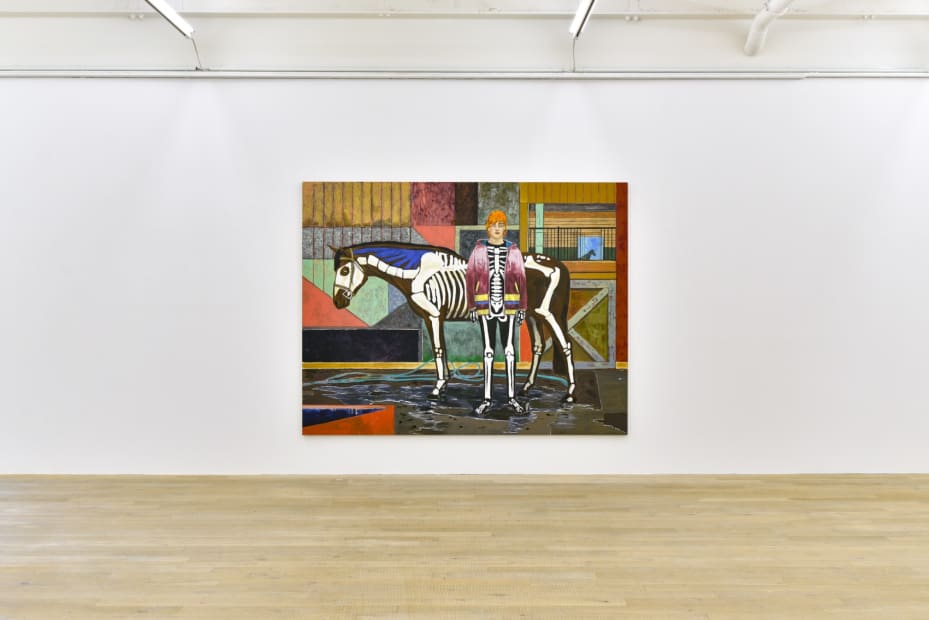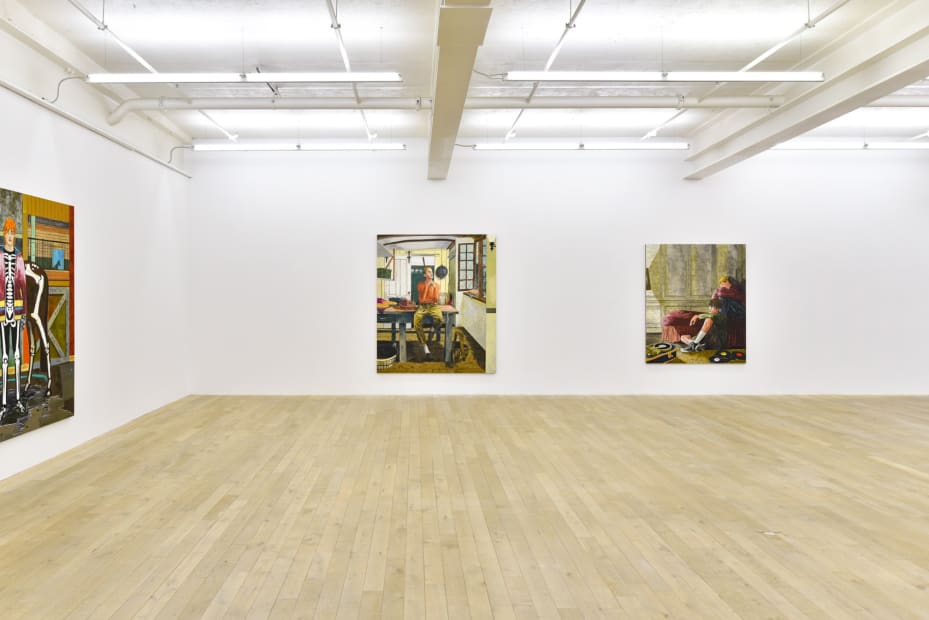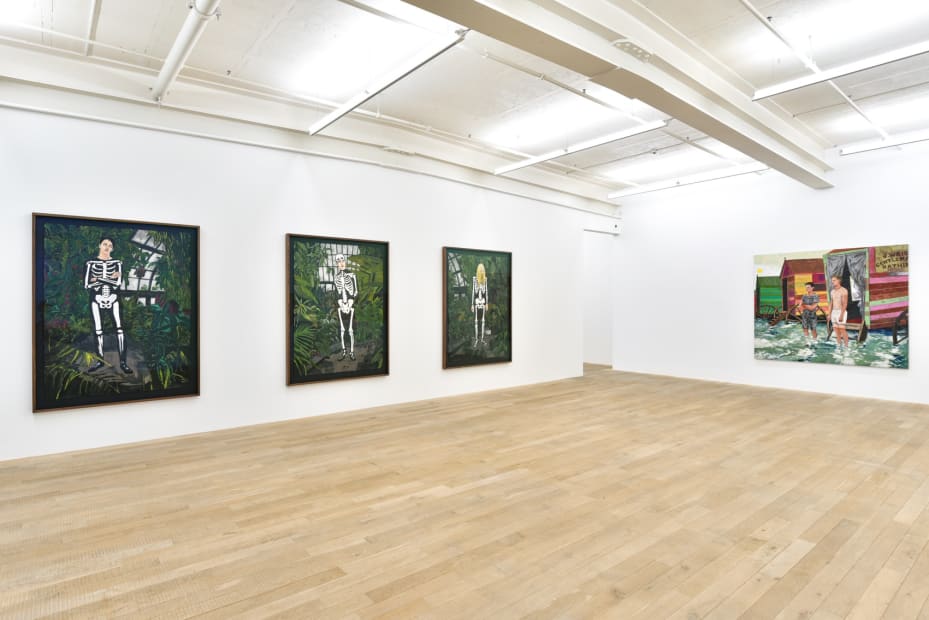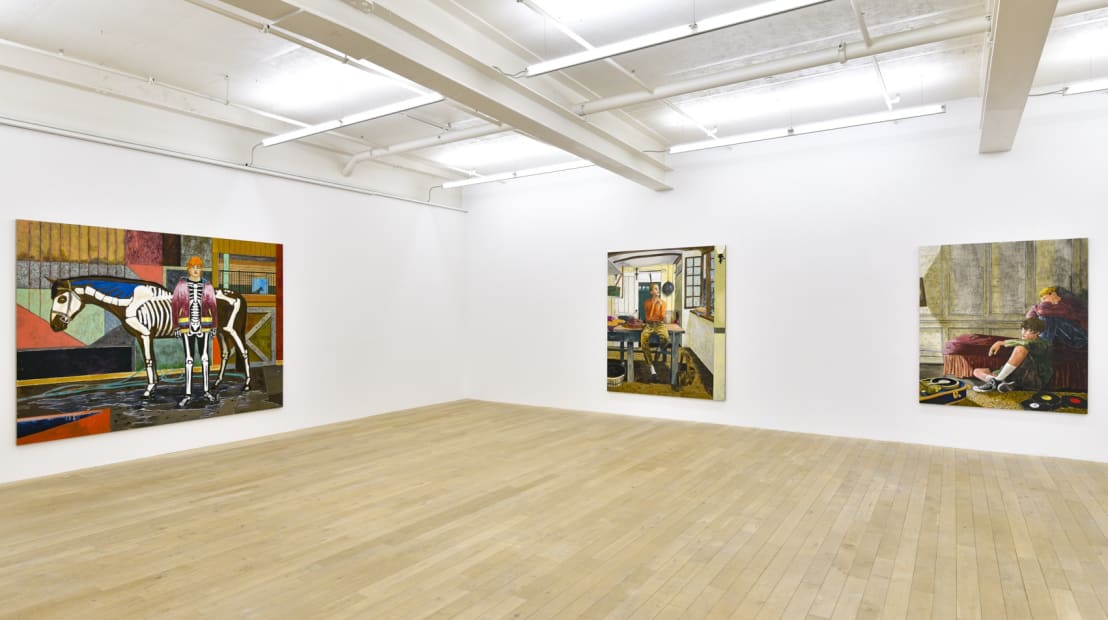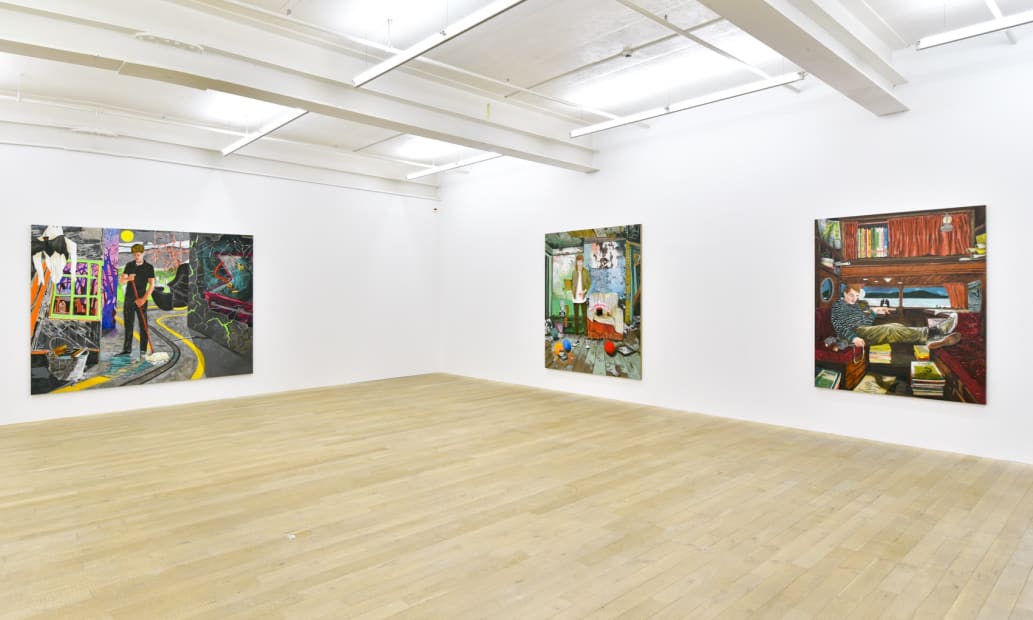Bas’ wide cultural-historical literacy has always been a fertile source of inspiration for the artist. In search of subject matter, he delves into narrative threads in literary works of mythology, history, religion and fiction. Key individual moments are then interwoven with his own imagination to form many-layered paintings of sometimes researched, sometimes devised adventures with a mostly androgynous protagonist in the bloom of his adolescence.
In Bas’ new group of works his research led him to a series of bizarre, sometimes paranormal incidents and legends from the recent past which are recounted to the viewer by the painted details of interiors of certain eras. It is an enigmatic world surrounding young protagonists such as the British Nessy hunter Steve Feltham and the American medium Matthew Manning, as well as anonymous characters whose story-lines reflect the humor of absurd traditions or a strange Zeitgeist through humorously overlaid tropes and clichés. The interior as setting is consciously chosen and shows Bas’ strong interest in very particular objects and designs, which not rarely come from his own collection of curiosities and serve as props in his studio.
In the work "The Shaker with a sweet tooth", 213.5 x 183 cm (84 x 72 in.) for example, Bas was inspired by the aesthetics of Shaker furniture. The reduced design of the furniture in a rustically furnished kitchen becomes the backdrop for an ironically connoted cliché of an ascetic way of life. Intending to remove a tooth by the good old method, the Shaker youngster has tied a string to his loose tooth but its other end is not connected to the usual doorknob but rather to a freshly baked cake on the window sill. Instead of eating the cake himself he waits until the sweet smell, which can be seen drifting from the cake as fumes, attracts a thief.
The work "The Monster Hunter (or desperately seeking Nessie)", 183 x 152.5 cm (72 x 60 in.), shows a scene from the life of Steve Feltham, the Guinness world-record-holder for the longest search for the Loch Ness Monster. In 1991, at the age of twenty-eight, he parked his van, a converted mobile library, on the shore of the mysterious loch and remained on vigil ever since. Feltham depicted here is still young and hopeful. Embedded in an exuberant abundance of carefully arranged details such as books, rolled maps and binoculars he leans tensely against the window as the moon rises outside. With his left hand he forms a shadow puppet gesture which throws the shadow of the cliche outline of the famous monster onto the bottom of the picture. Among other indications of the subject of his search are the minutely painted silhouettes of the monster on a sketch lying on the floor. At the beginning of his quest Feltham had just one fleeting glimpse of the monster and since then has never seen it again.
For the work "The curious case of Matthew Manning poltergeist", 183 x 152.5 cm (72 x 60 in.; see invitation card), Bas undertook in-depth research into one of the most extraordinary poltergeist phenomena of the 20th century. In the 1960s, apparently haunted by a spirit, the teenager Matthew Manning began to write in various languages and characters and to draw the works of dead artists. One day, as if by an invisible hand, six hundred signatures from six centuries appeared on his bedroom wall. Bas’ painting shows the young Manning sitting in his room in a contemplative attitude with a friend. The mundane retro record player and the records lying around in the foreground stand in contrast to the occult ambience produced by the numerous names on the wall in the background and the obscure cast of shadow moving into the picture from the right. The majority of the signatures are meticulously worked copies of the originals which Bas knew from photographs.
Another work concerned with the paranormal is "The ghost hunter (with trigger objects)", 213.5 x 183 cm (84 x 72 in.). The enigmatic idea of ghost hunters has been extremely popular since the turn of the century. The scene in Bas’ painting is oriented towards the stereotypical image of the young, athletic ghost hunter primarily shaped by television shows since the 1990s. With slightly arrogant, shadowy, droopy eyes he appears to be critically examining his surroundings from top to bottom. The setting is a long-abandoned dilapidated room as can be found in many places in Detroit — the artist’s second home. An electromagnetic field detector in the hunter’s hand and a REM pod on the chair in the background seem to be indicating the presence of paranormal activity by lighting up red. The three balls in primary colours pay subtle homage to John Baldessari.
In "The rebel (with tan lines)", 183 x 213.5 cm (72 x 84 in.) the artist is concerned with a mobile bathing hut, as introduced in the Victorian era to enable the preservation of public decency when bathing in the sea. These bizarre contrivances were very popular for some time and the interiors of some of them were reminiscent of luxury bath houses. The “rebel” in the scene is the one not preserving decorum with the usual men’s swimming costume. However, the deep sun-tan lines on his arms and legs reveal that his emancipation from convention can only have happened recently. A detail of the discarded striped costume protrudes from the inside of the bathing hut behind him.
A significant painting for Bas’ overall practice is "The haunted house keeper", 213.5 x 274.3 cm (84 x 108 in.), in which a young man is cleaning the interior of a ghost train. As a young boy, it was a test of courage to survive the horrors of a ghost train and live to tell the tale. As such, the ghost train can be seen as a metaphor for the transition from boyhood to maturity — a threshold upon which most of Bas’ characters can be found. For the young man now working in the “realm of the spooks”, all things that previously scared him have become merely props that he must keep in good condition. The illusions that were once so fascinating are now revealed in daylight as primitive tricks. The tragedy of this realization is underlined by the shabby walls and cracked shapes of phantoms on each side of the picture.
As in past series, the group of works on show fully exploits the enormous potential of the genre of painting in its technical and narrative possibilities. There are spaces with depth of perspective that draw the viewer into a world between reality and poetical fiction. Despite the painterly perfectionist details which allow for continual new discoveries, the young male figure remains prominent in all the compositions. The view of the beholder is repeatedly led to the faces of the protagonists whose dreamy- relaxed, sometimes challenging, facial expressions always remain unfathomable.

